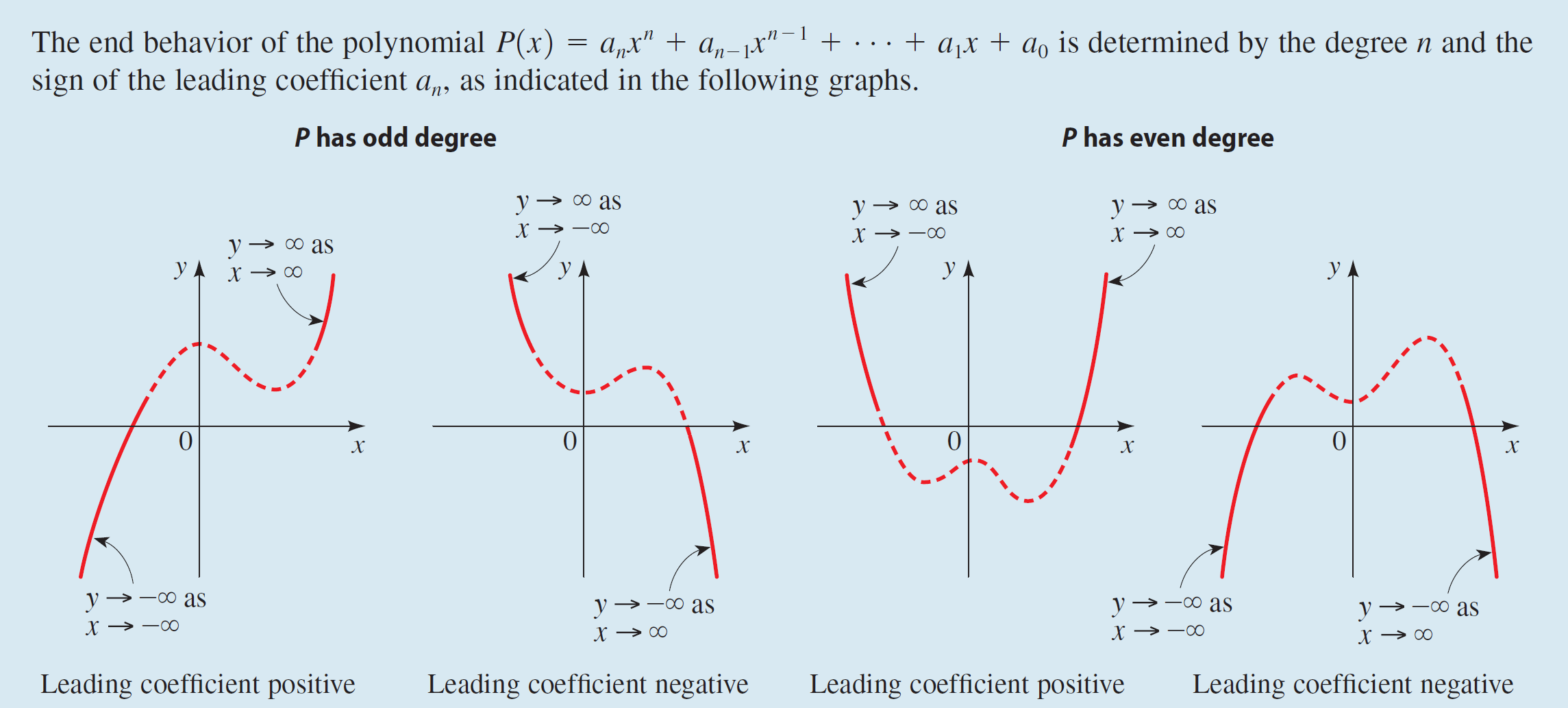3.2: Polynomial Functions and Their Graphs
What Are We Doing?
This section wil show you:
- what graphs of polynomials look like.
- how to graph a polynomial by hand using end behavior and $x$-intercepts.
Vocabulary
Here's the definition of a polynomial with some extra identifiers:
A polynomial function of degree $n$ is a function of the form \[P(x) = a_nx^n + a_{n-1}x^{n-1} + \cdots + a_1x + a_0 \qquad a_n \neq 0\] where $n$ is an integer.
- $a_n, a_{n-1}, \dots, a_1, a_0$ are called the coefficients.
- $a_0$ is called the constant coefficient or constant term.
- $a_n$ is called the leading coefficient.
- $a_nx^n$ is called the leading term.
Monomials
A monomial has the form $P(x) = x^n$. These graphs have three possible types of shapes, depending on $n$:



 $n$ is even
$n$ is even
 $n$ is odd
$n$ is odd

The monomial shapes are important to remember. Their shapes, as we will see, appear in the graph of every polynomial.
Polynomial Graphs
Polynomials have domain $\mathbb{R}$, and their graphs are continuous:
A graph is continuous if you can draw it without lifting your pencil.
In Calculus, you will learn the official definition.
Moreover, there cannot be any corners or sharp corners (cusps):


 Graphs of Polynomials
Graphs of Polynomials

Polynomial graphs can be broken up into two main ideas: end behavior and zeros.
End Behavior
Let's start with the "ends" of the graph. First, notation:
- $y\rightarrow \infty$ means $y$ grows without bound. Meaning, $y$ is bigger than any number you can think of!
- $y\rightarrow -\infty$ means $y$ decreases without bound.
The end behavior of a polynomial depends on the degree $n$ and the leading coefficient $a_n$:

Zeros ($x$-intercepts)
Now we look between the "ends".
Suppose $P$ is a polynomial and $c$ is a real number. Then the following are equivalent:
- $c$ is a zero of $P$.
- $c$ is a $x$-intercept of the graph of $P$.
- $x = c$ is a solution of the equation $P(x) = 0$. Meaning, $P(c) = 0$.
- $(x - c)$ is a factor of $P(x)$.
If $P$ is a polynomial and $P(a)$ and $P(b)$ have opposite signs, then there exists at least one value $c$ between $a$ and $b$ where $P(c) = 0$.
Consequence of IVT: between two successive zeros, $P(x) > 0$ or $P(x) < 0$.
Putting it all together:
- Find zeroes: Factor and solve for $x$.
- IVT test points: Make a sign diagram of $P(x)$ and whether it's $+$ or $-$ between two successive zeros.
- Find end behavior.
- Graph: Connect the end behavior, signs, and zeros in a smooth and continuous fashion.
In this example, $(x-2)^2$ looks like a parabola near $x = 2$ (think horizontal shift from $x^2$ right two units).
The power tells you the shape. They correspond to the monomial shapes.
Shape of a Graph Near a Zero
$c$ is a zero of multiplicity $m$ if $(x - c)^m$ appears in the factorization of $P$.
If $c$ is a zero of multiplicity $m$, then the graph shape near $c$ corresponds is as follows:
 or
or
 $n$ even
$n$ even
 or
or

$n \neq 1$
 or
or
 $n$ even
$n$ even
 or
or
